

Programming to Promote Diversity. The American Library Association recognizes the critical need for access to library and information resources, services, and technologies by all people, especially those who may experience language or literacy-related barriers; economic distress; cultural or social isolation; physical or attitudinal barriers; racism; discrimination on the basis of appearance, ethnicity, immigrant status, religious background, sexual orientation, gender identity, gender expression; or barriers to equal education, employment, and housing.
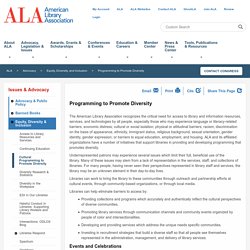
ALA and its affiliated organizations have a number of initiatives that support libraries in providing and developing programming that promotes diversity. Underrepresented patrons may experience several issues which limit their full, beneficial use of the library. Many of these issues may stem from a lack of representation in the services, staff, and collections of libraries.
Libraries can help eliminate barriers to access by: Tackling the Challenges of Implementing Diverse Libraries at Your School. Among the many roles Jill Eisenberg plays as Director of Curriculum and Literacy Strategy at Lee & Low Books, a critical one is working with schools across the country to diversify their libraries.
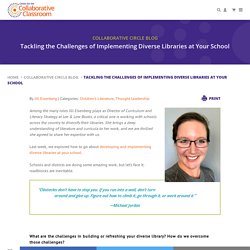
She brings a deep understanding of literature and curricula to her work, and we are thrilled she agreed to share her expertise with us. Tolerance. Does My Collection Reflect My Community? Diversity in the School Library. Shannon McClintock: Welcome, everybody, to our Future Ready Librarian Webinar.

I’m so excited for our April webinar. And as you know, my name is Shannon McClintock Miller. I am the district teacher librarian at Van Meter Community School in Iowa and the Future Ready Librarians Spokesperson. Also, you can find me on my blog at The Library Voice and on Twitter and Instagram @shannonmmiller. And so we’re so excited to have everybody here for this webinar, and we’re now into the third year. And so we’ve had quite a few. Also, I wanted to just share the #FutureReady, as well.
Can Diverse Books Save Us? In a divided world, librarians are on a mission. We Need Diverse Books – weneeddiversebooks.org. Teachers Push for Books With More Diversity, Fewer Stereotypes. In these 2017 photos, students in Noelle Mapes' 3rd grade class complete an audit of the books in their library.

They tracked the racial breakdown of the main characters in the stories and determined that they were overwhelmingly white. The exercise is meant to illuminate the lack of diversity in children's literature. —Noelle Mapes Most texts feature white characters For decades, children's books in school libraries and classrooms have overwhelmingly featured white faces.
Some educators and children's book authors are trying to change that. Nonprofits like We Need Diverse Books advocate for children's literature that better reflects the experiences of all young readers. The ripples of this ongoing conversation have reached a lot of classrooms, said Jess Lifshitz, a 5th grade teacher at Meadowbrook Elementary School in Northbrook, Ill. "More teachers now know it's the right thing to have books that represent a wide variety of people," said Lifshitz. Important Messages Auditing the Classroom. Teachers Push for Books With More Diversity, Fewer Stereotypes. There is no diverse book — ImagineLit. If you have ever attended any session where I have presented and the topic of diversity has come up, you know I am quick to tell attendees that I do not give out diverse book lists.
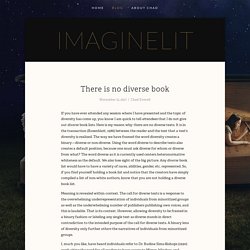
Here is my reason why: there are no diverse texts. It is in the transaction (Rosenblatt, 1986) between the reader and the text that a text’s diversity is realized. The way we have framed the word diversity creates a binary—diverse or non-diverse. Using the word diverse to describe texts also creates a default position, because one must ask diverse for whom or diverse from what? The word diverse as it is currently used centers heteronormative whiteness as the default. Meaning is revealed within context. I, much you like, have heard individuals refer to Dr. I also question if many diverse book lists consider who is telling the story. A hammer is just a hammer until it is placed in the hands of master craftsperson. #act4teens: The Inclusive Library: More than a Diverse Collection: Part 2.
In this second blog post on creating inclusive libraries, we examine the need to identify and remove barriers, and have an expanded definition of ‘the library as a safe space’.
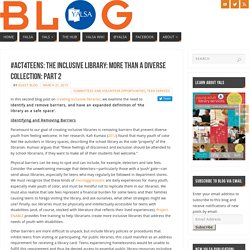
Identifying and Removing Barriers Paramount to our goal of creating inclusive libraries is removing barriers that prevent diverse youth from feeling welcome. #act4teens: The Inclusive Library: More than a Diverse Collection: Part 1. Three Cool Tools for Collection Development. Workflow | September 18, 2017 Your school library's collection development strategy will help you identify the right resources to support student learning and classroom instruction.
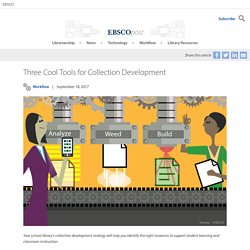
Three Cool Tools for School Library Collection Development As you prepare your library for the new school year, it’s a good time to review your collection development policy around digital resources. How well does your school library collection meet the needs of your users? Consider your students, teachers, support staff, administrators and parents. According to the American Library Association’s Library Bill of Rights, “School librarians cooperate with other individuals in building collections of resources that meet the needs as well as the developmental and maturity levels of students.
Step 1: Collection Analysis - Assess What You Have Begin by identifying your library’s strengths and weaknesses. Step 2: Weeding - Remove What You Don’t Need. School Library Journal.